An embroidery hoop appears like a beautiful essential piece of hardware, doesn’t it? An embroidery hoop or frame is made of wood, and the embroidery fabric is extended rigid and pinned, attached, or sewn in a few ways onto the frame.
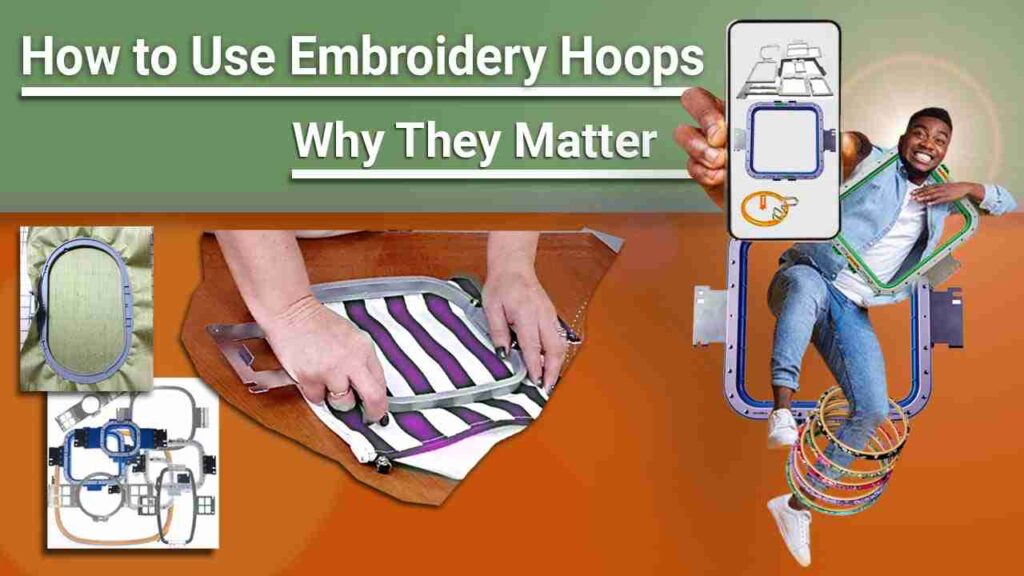
How To Use Embroidery Hoops With Pros and Cons
Introduction:
It comprises a pair of concentric circular or curved rings. The big ring features a fixing gadget in the shape of a metal screw. The frame is moveable due to tapped ends.
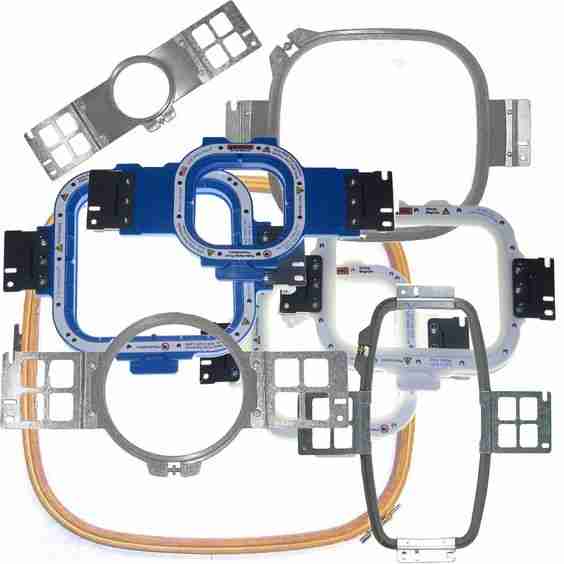
Embroidery hoops come in different sizes depending on the work, either a large piece of fabric or a medium one. Embroidery hoops give us ease to work on fabric. Some hoops mostly used in machine embroidery like Magnetic Embroidery Hoops could be used with any fabric type.
We can do embroidery or other works of art such as painting, zardozi work, etc. Hoops were initially made of wood, bone. Advanced hoops are made of wood or plastic. Standing floor frames and lap frames permit the crafter to keep both hands free for working, which increments the work’s accuracy and speed. Before going into further details that how to use embroidery hoops, let’s go through type of Embroidery Hoops.
Embroidery Digitizing
&
Vector Art Services
Are you looking for embroidery digitizing and vector art services at low cost with superfast turnaround, guaranteed quality and preview before pay? So, you are at right place. We can digitize and vectorize any type of artwork in your required file format.
Types Of Embroidery Hoops:
There are numerous working frames accessible nowadays that are easy to use and can be moved around easily. The variety is so huge that people get confused over which sort to select.
- Round embroidery hoops
- Quilting hoops
- Spring tension hoops
- Easy clip frames
- Slate frames
- Hand-free stitching frames
Round Embroidery Hoops :
Round Embroidery hoops are typically 10mm deep and size ranges from 3″ to 12″ in diameter. Round hoops are used in many needle crafts, such as cross-stitching. They are available in wood and plastic materials and used for small embroidery work.
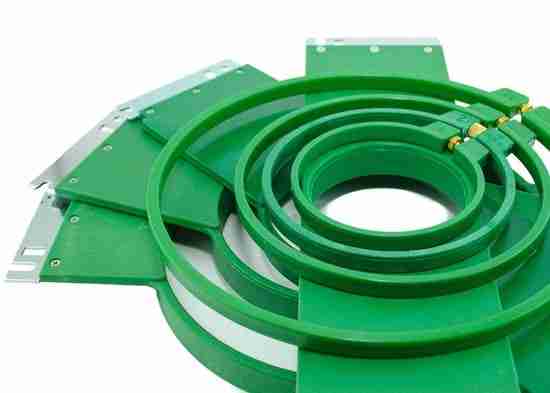
Pros:
When freestyle and counted embroidery have to be done, these hoops are easy and quick to be positioned or removed as required.
Cons:
These hoops are not suitable for canvas work.
Quilting Hoops:
Quilting hoops are 25mm deep and their size range from 12’’ to 18’’ diameter. These hoops are bigger than embroidery hoops and can support thick fabrics.
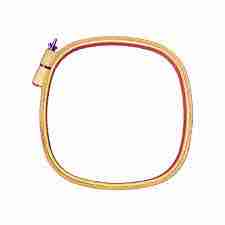
Spring tension Hoops :
Spring tension hoops have size ranges from 3’’ to 7’’ in diameter. These are more expensive because of having an inner metal ring that provides tension.
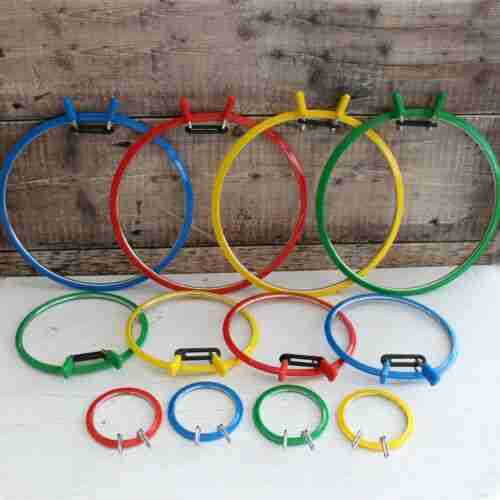
Pros:
These are easier to adjust due to the inner metal ring than the hoops with screw lighteners.
Cons:
A little bit pricier than the wooden hoop.
Easy clip frames:
The fabric is held with plastic clips that move on the roller. The easy clip is a type of roller frame that does not require stitching on fabric. The frame holds linen cloth and canvas.
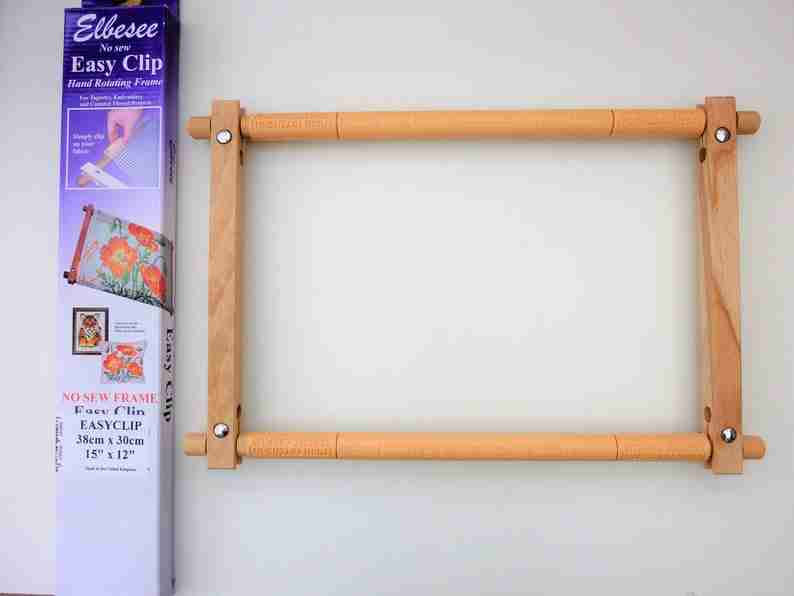
Pros:
- Good tension
- Quick to assemble
- A lot of sizes
Cons:
The frame is heavy.
Slate frames:
Slate frames are used for very large projects .fabric fits along the roller bars’ width and the excess fabric is rolled onto the roller bars.
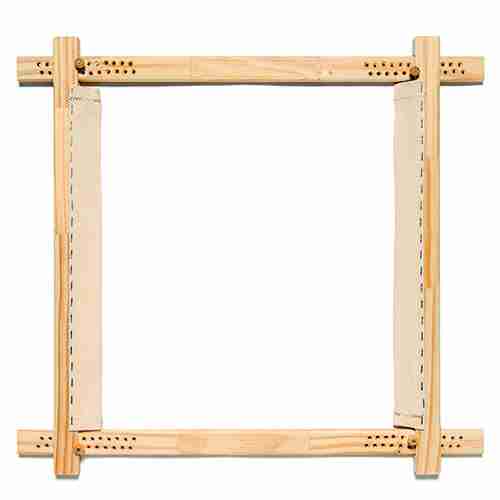
Pros:
- Fits a large piece of fabric
- Leave both hands free for two-handed embroidery
Cons:
- Not commonly available
- They are expensive
- Large and heavier
Hand-free stitching frame:
These frames are more comfortable to use if we place them on the seat stand or floor. Stitching design can be fast as both handed stitchings can be performed easily on this frame.
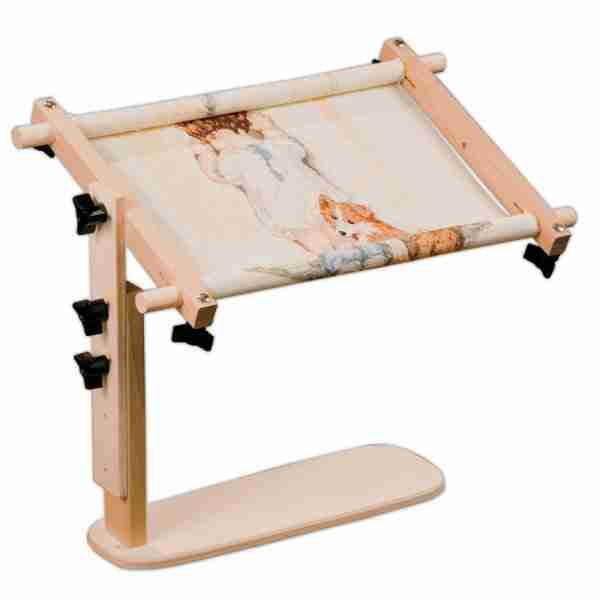
How to Use embroidery hoops, pratically ?
We have discussed the types of Hoops, but to know how to use embroidery hoops ? read further.
We are going to set up the fabric in the hoop. For this, what we have to do is as follows;
- First, we need to unscrew the screw on the outer hoop
- If a thick piece is to be held with hoops, then loosen the hoops more
- Separate the two pieces of hoop
- Place the fabric on a smaller hoop
- Place the outer hoop and gently press with both hands, tighten the hoops
- If fabric feel loose, tighten the screw
- Press from all sides and straighten the fabric
Uses of Embroidery hoops :
The embroidery hoop can be utilized for small and large surface embroidery projects. Embroidery hoops and frames are apparatuses utilized to keep fabric rigid, whereas working embroidery or other needlework shapes. On little projects, it is best in case the band encompasses the full project design zone.
On massive projects (such as table clothes) worked in surface weaving, the hoop is moved from place to place on the project. Comfort ought to be a priority. Comfortable hoops are most appropriate for embroidering work.
Size of the embroidery hoop and your hand :
While choosing a hoop, it should keep in mind the size of future embroidery. When buying a hoop, it needs to be the one that fits well for one’s hands. The 7″ diameter hoop fit my hand. Anything more significant gets to be lumbering when embroidering the center of the plan. I, for the most part, like 6″ and 7″ hoops best. Classic hoops are relatively easy to use and handle as well.
Larger hoops require a stand for support and can work with your both hands-free to reach either at the center or any edge of the frame quickly. Thin hoops made up of plastic are also used in machine embroidery.
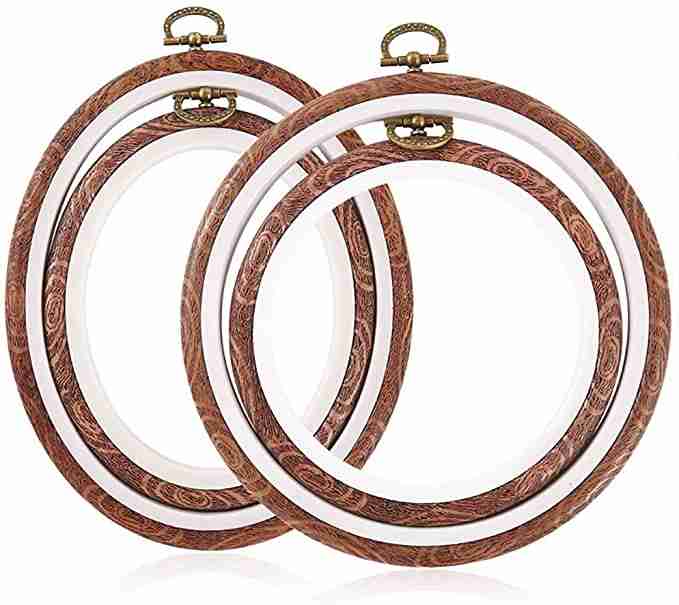
Quality of Embroidery hoop :
The Low-quality hoop may be a threat to the fiber if used incorrectly. It would be best if you considered the quality of hoops well. Low-price plastic hoops have their side effects also. They crack easily.
The wood quality also matters a lot; Bamboo is the most preferred wood for them. Otherwise, the unpleasant smell of the wood may disappear after the first wash but affects the fabric.
Why do Embroidery hoops matter ?
The main reason why the hoops were invented is that it keeps the fiber tight and allow us to work on fabric. When wrapping the hoops, it provides perfect friction and tension to the fiber and keeps the fiber in place quickly for a longer time.
Pros and cons of embroidery hoops:
The Embroidery design is truly a vital process for dress or embroidery items and ordinarily, people who work in related fields truly require appropriate embroidery plans on their embroidery item. There are endless benefits to utilizing the embroidery circle for getting an appropriate embroidery plan on the texture.
Pros:
It idealizes sew out of the plan in a master way since it sets the plan within the loop criteria to print the plan on the correct location by utilizing embroidery techniques.
- Embroidery hoops are relatively comfortable while holding the hand.
- It is doubtlessly a professional way of doing embroidery on the fabric.
- It reduces the chances of mistakes after sew out so easily.
- It will surely decrease working time and fabric costs.
Cons:
- The hoops cause ring marks which can be removed from washable embroidery projects but cannot be washed from the silk embroidery work or fabric like silk and velvet.
- For larger projects, big hoops are required that are not commonly available and are costly.
- They require a long time to prepare a dress and are big and bulky in structure.
Conclusion:
An embroidery hoop can either make or break the project. Before deciding which hoops to choose; you have to learn how to use Embroidery Hoops. Choosing a hoop blindly might lead to a lot of issues in the end; you must pick the right one. Now you have a great idea of embroidery hoops.
Now, it this your turn to ask yourself, which embroidery hoop do you prefer? When do you use these hoops, and when don’t you?
Frequently Asked Questions:
Plastic hoops are the best choice. The no-slip embroidery hoops hold the material extremely tight and so do Flexi hoops (the kind that stretches over the material). The only downside is that few of the no-slip hoops come in extremely bright colors, so you might need to buy a separate hoop for showing your embroidery afterward. For beginners, any embroidery hoop would work fine as long as it holds the material fine. A small hoop, like 4 to 6-inch embroidery hoops is the best size, to begin with as they are simple to hold while you are stitching and they are an amazing size for novice projects.
An embroidery hoop or tambour frame has a pair of concentric circular or elliptical rings. The bigger ring has a tightening device, generally in the form of a metal screw. The artisan repositions the hoop as required when functioning over a huge piece of material. Embroidery hoops do come in different shapes. Embroidery hoops are most commonly round, but you could as well find square and oval shapes. Round embroidery hoops are accessible in a huge range of sizes, while square and oval sizes are most limited. You do not necessarily require a square hoop when you are stitching a square design, but it could help if you need to fit the complete design within the embroidery hoop.
Plastic hoops are the best choice. The no-slip embroidery hoops hold the material extremely tight and so do Flexi hoops (the kind that stretches over the material). The only downside is that few of the no-slip hoops come in extremely bright colors, so you might need to buy a separate hoop for showing your embroidery afterward. For beginners, any embroidery hoop would work fine as long as it holds the material fine. A small hoop, like 4 to 6-inch embroidery hoops is the best size, to begin with as they are simple to hold while you are stitching and they are an amazing size for novice projects.
Yes, embroidery hoops are reusable. You can use a standard wood or plastic embroidery hoop for an extended time. These embroidery hoops could last a lifetime, relying on how they are used, cleaned, and kept. Old embroidery hoops could as well repurposed into different DIY embroidery projects.
Hoops are accessible in a range of sizes from as small as three inches in diameter to as big as twelve inches or more. Hoops designed for quilting could be even bigger. Smaller hoops are usually simpler to hold while you stitch as compared to bigger ones. Ideally, select a hoop that is about one inch bigger than the design you are stitching. Holding a hoop that is bigger than eight inches could be heavy, so for bigger pieces, it is fine to recenter the material in the hoop as required, only make sure to take the material out of the hoop always when you are not stitching.












